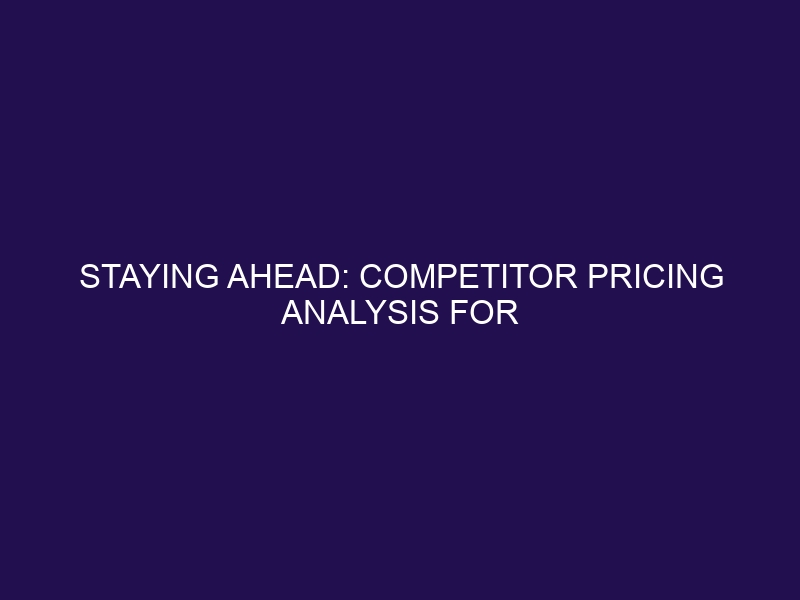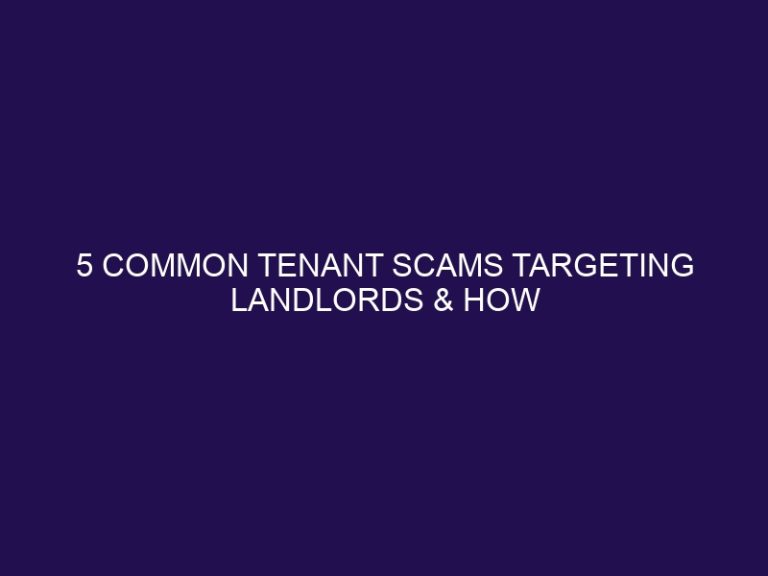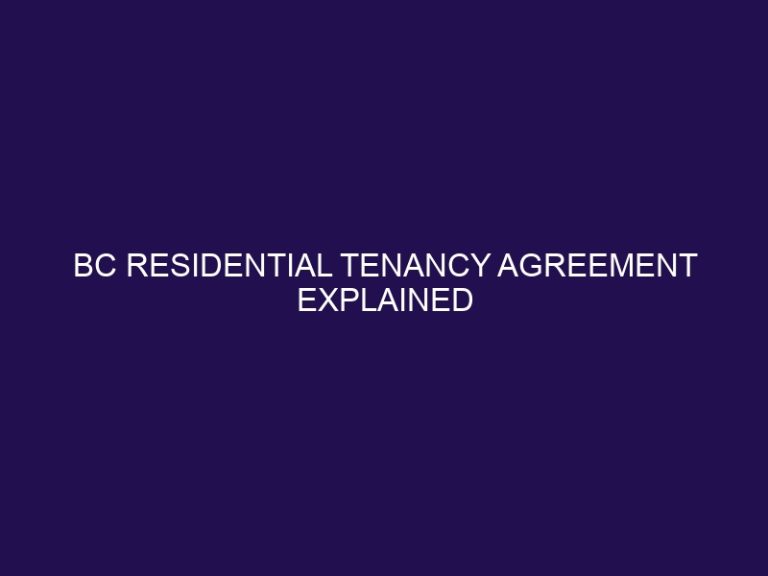Staying Ahead: Competitor Pricing Analysis for Landlords
Competitor pricing analysis for landlords is the process of researching and comparing the rental rates of similar properties in the same location. It involves identifying competitors, gathering data on their rental properties, analyzing the data, and determining your own pricing strategy. This analysis is crucial for landlords to stay competitive and maximize their profits in the rental market.
Conducting competitor pricing analysis is essential for landlords as it allows them to understand the current market trends and make informed decisions about their rental rates. By staying updated on the pricing strategies of their competitors, landlords can ensure they are offering competitive rates without compromising their profitability.
To conduct a thorough competitor pricing analysis, landlords should follow these steps:
- Identify Your Competitors: Start by identifying your direct competitors in the same location. These are properties that are similar in size, amenities, and location.
- Gather Data on Their Rental Properties: Use online rental listing websites or speak to other landlords to gather data on their rental rates, vacancy rates, and amenities offered.
- Analyze the Data: Once you have gathered the data, analyze it to identify any trends or patterns in pricing strategies.
- Determine Your Own Pricing Strategy: Based on your analysis, determine the most competitive rental rate for your property while still ensuring profitability.
When conducting competitor pricing analysis, landlords should consider factors such as location, property size and amenities, market demand, and tenant demographics. These factors can greatly influence the rental rates in a particular area.
There are several benefits of conducting competitor pricing analysis for landlords. It helps them set competitive rental rates, attract quality tenants, maximize their profit potential, and identify market trends. However, there are also challenges, such as gathering accurate data, keeping up with constant changes in the market, and balancing competitive rates with profitability.
In conclusion, conducting regular competitor pricing analysis is crucial for landlords to stay ahead and succeed in the rental market. By understanding their competitors’ pricing strategies and market trends, landlords can make informed decisions to set competitive rental rates and attract quality tenants.
What Is Competitor Pricing Analysis for Landlords?
What Is Competitor Pricing Analysis for Landlords? This process involves closely examining the rental rates, concessions, and amenities provided by competing properties in the same market in order to develop effective pricing strategies and stay ahead of the competition.
Why Is Competitor Pricing Analysis Important for Landlords?
Why Is Competitor Pricing Analysis Important for Landlords? Competitor pricing analysis is essential for landlords as it allows them to set competitive rental rates, stay updated on market trends, and optimize property income. A pro-tip is to regularly monitor rental rates in the area to make necessary price adjustments and stay ahead in the rental market.
How to Conduct Competitor Pricing Analysis for Landlords?
In the competitive world of being a landlord, staying ahead of the game is crucial to success. One way to gain an edge is by conducting a competitor pricing analysis. This section will guide you through the process of analyzing your competitors’ pricing strategies to inform your own. We will discuss the key steps of identifying your competitors, gathering data on their rental properties, analyzing the data, and ultimately determining your own pricing strategy. With this knowledge, you can make informed decisions to stay ahead of the competition.
1. Identify Your Competitors
- Conduct research on local rental listings and property management companies.
- Utilize online rental platforms to identify similar properties in your area.
- Engage in market research to identify any new or emerging competitors.
2. Gather Data on Their Rental Properties
- Review online rental listings, including property size, amenities, and rental prices.
- Utilize real estate databases to gather data on comparable rental properties in the area, including those owned by competitors.
- Consider visiting open houses or contacting property managers for firsthand information.
- Engage with local real estate agents to understand market trends and rental rates, including those of competitors.
Staying Ahead: Competitor Pricing Analysis for Landlords
3. Analyze the Data
- Organize the gathered data into categories such as property type, location, and amenities.
- Compare the rental rates of similar properties in the vicinity.
- Analyze the Data by examining the average, highest, and lowest rental prices to identify trends.
Fact: Analyzing data helps landlords make informed pricing decisions.
4. Determine Your Own Pricing Strategy
- Assess the gathered competitor pricing data.
- Consider the property’s uniqueness and amenities.
- Analyze market demand and tenant demographics.
- Formulate a pricing strategy balancing competitiveness and profitability.
- Finally, determine your own pricing strategy by taking into account all of the previous factors.
What Factors Should Be Considered in Competitor Pricing Analysis for Landlords?
When it comes to setting rental prices for your property, it’s essential to understand how your competitors are pricing their rentals. By conducting a thorough competitor pricing analysis, landlords can gain valuable insights into the market and make informed decisions on their own pricing strategy. In this section, we will discuss the key factors that should be considered in competitor pricing analysis for landlords, including location, property size and amenities, market demand, and tenant demographics. With a deeper understanding of these factors, landlords can stay ahead of the competition and attract the right tenants for their property.
1. Location
- Research the desirability and proximity of the neighborhood to amenities.
- Analyze the rental market trends and demand in the area.
- Consider the impact of location on property value and tenant preferences.
2. Property Size and Amenities
As a landlord, it is important to consider both the size of the property and the amenities it offers when analyzing competitor pricing. Properties with larger sizes and additional amenities such as gyms or pools tend to demand higher rental rates. To accurately analyze this, it is essential to compare these factors with similar properties in your area. Taking these details into account will help you determine competitive rental rates.
3. Market Demand
- Assess local rental demand trends, considering vacancy rates and the length of time properties stay on the market.
- Review demographic shifts and employment opportunities that influence housing needs.
- Analyze rental listing data to gain insight into tenant preferences and make necessary adjustments.
Understanding market demand is essential for landlords to align their pricing strategy and property offerings with the needs and preferences of potential tenants.
4. Tenant Demographics
| Tenant Demographics |
|
A landlord carefully studied the 4. Tenant Demographics and made necessary adjustments to the property features, successfully attracting long-term tenants and ultimately increasing the property’s value.
What Are the Benefits of Conducting Competitor Pricing Analysis for Landlords?
As a landlord, staying ahead of the competition is crucial for success. One way to achieve this is by conducting a competitor pricing analysis. In this section, we will explore the benefits of this practice and how it can give landlords an edge in the rental market. From setting competitive rental rates to identifying market trends, we will discuss the various advantages of conducting a competitor pricing analysis. So, let’s dive in and see how this analysis can benefit landlords in their business.
1. Helps Set Competitive Rental Rates
- Analyze local rental market rates to understand the competitive pricing landscape and help set optimal rental prices.
- Compare property size, amenities, and location with similar listings to gauge competitive rates and determine the best pricing strategy.
- Consider market demand and tenant demographics when setting rental prices to ensure they are competitive and attractive to potential tenants.
2. Attracts Quality Tenants
- Highlight Property Features: Showcase unique amenities and features that cater to attracting high-quality tenants.
- Professional Marketing: Use professional photographs and detailed, compelling descriptions in property listings to attract quality tenants.
- Responsive Communication: Respond promptly to inquiries and maintain open communication throughout the rental process to attract quality tenants.
- Offer Incentives: Provide incentives such as flexible lease terms or utilities included to attract quality tenants who appreciate the attention to detail.
By highlighting the stunning views and modern amenities, a landlord successfully attracted quality tenants who appreciated the attention to detail and signed a long-term lease.
3. Maximizes Profit Potential
- Optimize Rental Rates: Analyze competitor pricing to set rates that maximize profit potential.
- Identify Value-Adds: Assess amenities and services to enhance property appeal and command higher rents.
- Monitor Market Trends: Stay updated on pricing shifts to capitalize on profit-driving opportunities that maximize profit potential.
4. Identifies Market Trends
Identifying market trends in competitor pricing analysis involves monitoring changes in rental rates over time, understanding shifts in tenant preferences, and recognizing emerging neighborhood or property features that affect rental values.
What Are the Challenges of Conducting Competitor Pricing Analysis for Landlords?
As a landlord, staying ahead of the game means understanding the pricing strategies of your competitors. However, conducting a thorough competitor pricing analysis can be a challenging task. In this section, we will discuss the main challenges that landlords face when gathering accurate data on their competitors’ pricing, keeping up with the constantly changing market, and finding the balance between competitive rates and profitability. By understanding these challenges, landlords can better navigate the competitive rental market and set themselves up for success.
1. Gathering Accurate Data
- Identify sources: Utilize property management software, online platforms, and local agents to gather accurate data.
- Verify information: Cross-reference data from multiple sources to ensure accuracy.
- Update regularly: Continuously monitor market changes and regularly adjust pricing strategies accordingly.
2. Keeping Up with Constant Changes in the Market
- Stay Informed: Regularly monitor rental trends, demand shifts, and new developments.
- Network: Engage with local real estate organizations, attend seminars, and join online forums for insights on keeping up with constant changes in the market.
- Adapt Quickly: Adjust pricing based on market fluctuations and competitor actions.
Staying agile in response to market changes is crucial for maintaining a competitive edge.
3. Balancing Competitive Rates with Profitability
- Assessing market demand and competitor rates.
- Analyzing costs to ensure profitability.
- Adjusting rates based on value-added amenities.
A landlord in a competitive market carefully balanced rental rates with profit by offering unique property features, attracting tenants, and yielding high returns.
Frequently Asked Questions
What are the key data and tools needed for a competitive market analysis?
- Key data includes current market prices, occupancy rates, and rental options of local competitors.
- Tools such as industry conferences, industry publications, and online real estate tools can provide valuable insights and trends.
How can understanding industry trends help landlords set competitive prices?
- Understanding industry trends through attending conferences, reading publications, and networking can provide valuable insights.
- Staying up-to-date on pricing trends can help set competitive rental rates.
What factors should landlords consider when setting rental prices?
- Factors such as location, amenities, and demand should be considered when determining rental prices.
- Regularly reviewing and adjusting rental prices to stay competitive is important.
What are some key tips for marketing rental properties in a competitive market?
- Highlighting unique features and amenities can make your property stand out.
- Utilizing effective marketing strategies, such as professional photos and virtual tours, can showcase your property’s unique features.
- Staying ahead of marketing trends and utilizing efficient marketing strategies can help attract more tenants.
How can technology give landlords a competitive advantage in the rental market?
- Utilizing technology, such as online rental applications and virtual tours, can make the rental process more convenient for potential tenants.
- Embracing smart home technology can also be a competitive advantage for attracting tech-savvy renters.
What are some important factors for landlords to consider when maintaining their rental properties?
- Regularly maintaining and repairing the property is crucial for attracting and retaining tenants.
- Responding promptly to maintenance requests and addressing any issues can improve tenant satisfaction and prevent potential problems from escalating.







